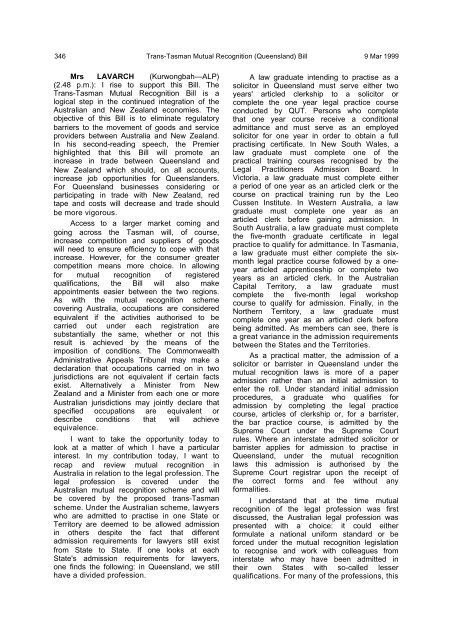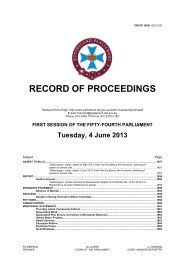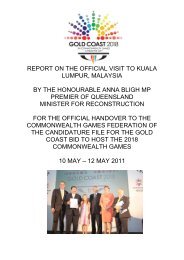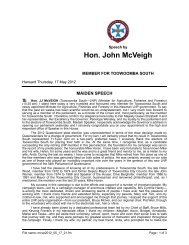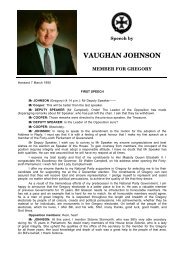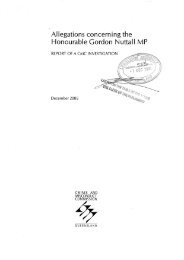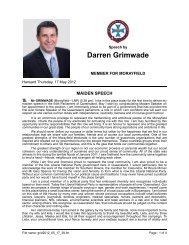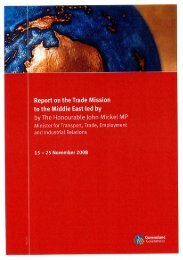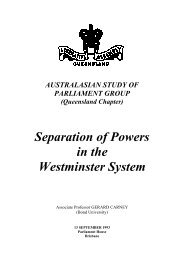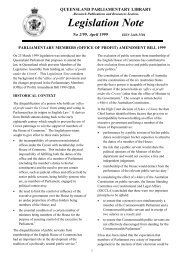Full transcript - Final - Queensland Parliament - Queensland ...
Full transcript - Final - Queensland Parliament - Queensland ...
Full transcript - Final - Queensland Parliament - Queensland ...
Create successful ePaper yourself
Turn your PDF publications into a flip-book with our unique Google optimized e-Paper software.
346 Trans-Tasman Mutual Recognition (<strong>Queensland</strong>) Bill 9 Mar 1999<br />
Mrs LAVARCH (Kurwongbah—ALP)<br />
(2.48 p.m.): I rise to support this Bill. The<br />
Trans-Tasman Mutual Recognition Bill is a<br />
logical step in the continued integration of the<br />
Australian and New Zealand economies. The<br />
objective of this Bill is to eliminate regulatory<br />
barriers to the movement of goods and service<br />
providers between Australia and New Zealand.<br />
In his second-reading speech, the Premier<br />
highlighted that this Bill will promote an<br />
increase in trade between <strong>Queensland</strong> and<br />
New Zealand which should, on all accounts,<br />
increase job opportunities for <strong>Queensland</strong>ers.<br />
For <strong>Queensland</strong> businesses considering or<br />
participating in trade with New Zealand, red<br />
tape and costs will decrease and trade should<br />
be more vigorous.<br />
Access to a larger market coming and<br />
going across the Tasman will, of course,<br />
increase competition and suppliers of goods<br />
will need to ensure efficiency to cope with that<br />
increase. However, for the consumer greater<br />
competition means more choice. In allowing<br />
for mutual recognition of registered<br />
qualifications, the Bill will also make<br />
appointments easier between the two regions.<br />
As with the mutual recognition scheme<br />
covering Australia, occupations are considered<br />
equivalent if the activities authorised to be<br />
carried out under each registration are<br />
substantially the same, whether or not this<br />
result is achieved by the means of the<br />
imposition of conditions. The Commonwealth<br />
Administrative Appeals Tribunal may make a<br />
declaration that occupations carried on in two<br />
jurisdictions are not equivalent if certain facts<br />
exist. Alternatively a Minister from New<br />
Zealand and a Minister from each one or more<br />
Australian jurisdictions may jointly declare that<br />
specified occupations are equivalent or<br />
describe conditions that will achieve<br />
equivalence.<br />
I want to take the opportunity today to<br />
look at a matter of which I have a particular<br />
interest. In my contribution today, I want to<br />
recap and review mutual recognition in<br />
Australia in relation to the legal profession. The<br />
legal profession is covered under the<br />
Australian mutual recognition scheme and will<br />
be covered by the proposed trans-Tasman<br />
scheme. Under the Australian scheme, lawyers<br />
who are admitted to practise in one State or<br />
Territory are deemed to be allowed admission<br />
in others despite the fact that different<br />
admission requirements for lawyers still exist<br />
from State to State. If one looks at each<br />
State's admission requirements for lawyers,<br />
one finds the following: in <strong>Queensland</strong>, we still<br />
have a divided profession.<br />
A law graduate intending to practise as a<br />
solicitor in <strong>Queensland</strong> must serve either two<br />
years' articled clerkship to a solicitor or<br />
complete the one year legal practice course<br />
conducted by QUT. Persons who complete<br />
that one year course receive a conditional<br />
admittance and must serve as an employed<br />
solicitor for one year in order to obtain a full<br />
practising certificate. In New South Wales, a<br />
law graduate must complete one of the<br />
practical training courses recognised by the<br />
Legal Practitioners Admission Board. In<br />
Victoria, a law graduate must complete either<br />
a period of one year as an articled clerk or the<br />
course on practical training run by the Leo<br />
Cussen Institute. In Western Australia, a law<br />
graduate must complete one year as an<br />
articled clerk before gaining admission. In<br />
South Australia, a law graduate must complete<br />
the five-month graduate certificate in legal<br />
practice to qualify for admittance. In Tasmania,<br />
a law graduate must either complete the sixmonth<br />
legal practice course followed by a oneyear<br />
articled apprenticeship or complete two<br />
years as an articled clerk. In the Australian<br />
Capital Territory, a law graduate must<br />
complete the five-month legal workshop<br />
course to qualify for admission. <strong>Final</strong>ly, in the<br />
Northern Territory, a law graduate must<br />
complete one year as an articled clerk before<br />
being admitted. As members can see, there is<br />
a great variance in the admission requirements<br />
between the States and the Territories.<br />
As a practical matter, the admission of a<br />
solicitor or barrister in <strong>Queensland</strong> under the<br />
mutual recognition laws is more of a paper<br />
admission rather than an initial admission to<br />
enter the roll. Under standard initial admission<br />
procedures, a graduate who qualifies for<br />
admission by completing the legal practice<br />
course, articles of clerkship or, for a barrister,<br />
the bar practice course, is admitted by the<br />
Supreme Court under the Supreme Court<br />
rules. Where an interstate admitted solicitor or<br />
barrister applies for admission to practise in<br />
<strong>Queensland</strong>, under the mutual recognition<br />
laws this admission is authorised by the<br />
Supreme Court registrar upon the receipt of<br />
the correct forms and fee without any<br />
formalities.<br />
I understand that at the time mutual<br />
recognition of the legal profession was first<br />
discussed, the Australian legal profession was<br />
presented with a choice: it could either<br />
formulate a national uniform standard or be<br />
forced under the mutual recognition legislation<br />
to recognise and work with colleagues from<br />
interstate who may have been admitted in<br />
their own States with so-called lesser<br />
qualifications. For many of the professions, this


